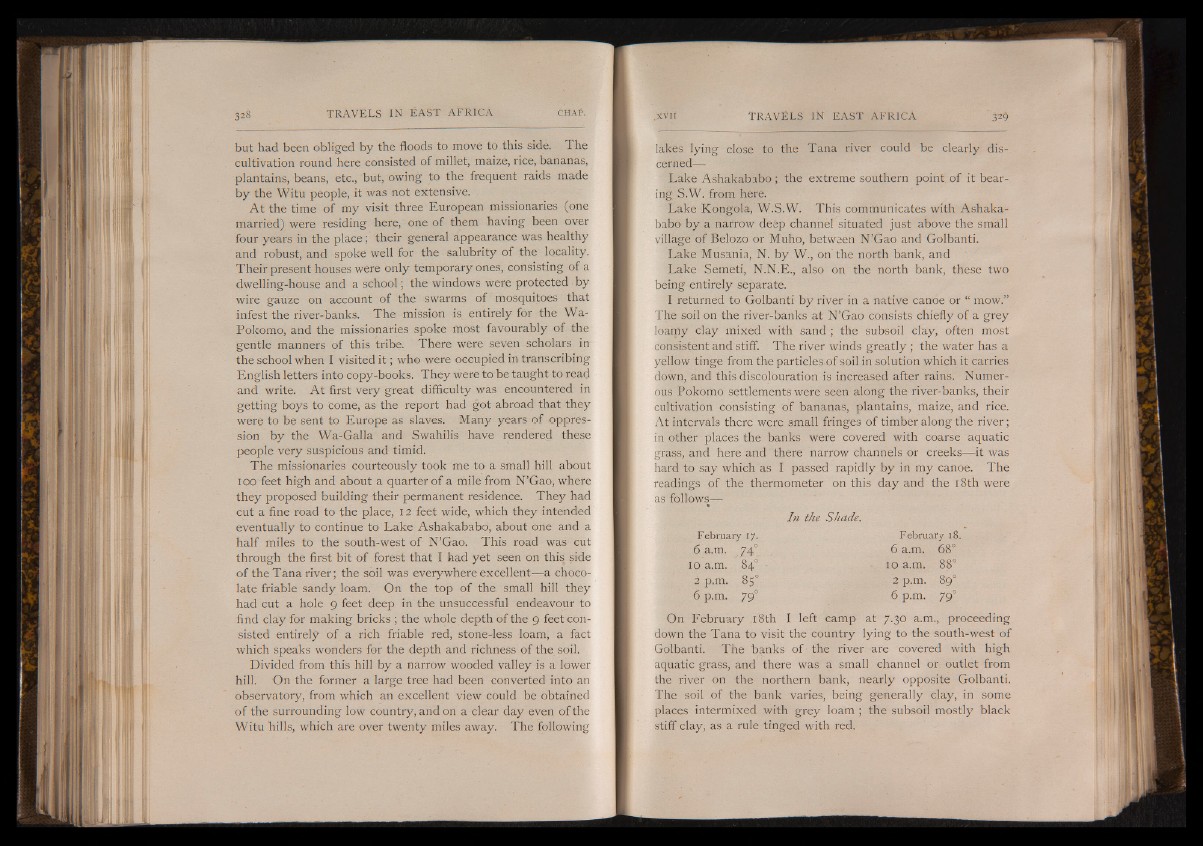
but had been obliged by the floods to move to this side. The
cultivation round here consisted of millet, maize, rice, bananas,
plantains, beans, etc., but, owing to the frequent raids made
by the Witu people, it was not extensive.
A t the time of my visit three European missionaries (one
married) were residing here, one of them having been over
four years in the place; their general appearance was healthy
and robust, and spoke well for the salubrity of the locality.
Their present houses were only temporary ones, consisting of a
dwelling-house and a school; the windows were protected by
wire gauze on account of the swarms of mosquitoes that
infest the river-banks. The mission is entirely for the Wa-
Pokomo, and the missionaries spoke most favourably of the
gentle manners of this tribe. There were seven scholars in
the school when I visited it ; who were occupied in transcribing
English letters into copy-books. They were to be taught to read
and write. A t first very great difficulty was encountered in
getting boys to come, as the report had got abroad that they
were to be sent to Europe as slaves. Many years of oppression
by the Wa-Galla and Swahilis have rendered these
people very suspicious and timid.
The missionaries courteously took me to a small hill about
ioo feet high and about a quarter of a mile from N’Gao, where
they proposed building their permanent residence. They had
cut a fine road to the place, 12 feet wide, which they intended
eventually to continue to Lake Ashakababo, about one and a
half miles to the south-west of N’Gao. This road was cut
through the first bit of forest that I had yet seen on this side
of the Tana river; the soil was everywhere excellent— a chocolate
friable sandy loam. On the top of the. small hill they
had cut a hole 9 feet deep in the unsuccessful endeavour to
find clay for making bricks ; the whole , depth of the 9 feet consisted
entirely of a rich friable red, stone-less loam, a fact
which speaks wonders for the depth and richness of the soil.
Divided from this hill by a narrow wooded valley is a lower
hill. On the former a large tree had been converted into an
observatory, from which an excellent view could be obtained
of the surrounding low country, and on a clear day even of the
Witu hills, which are over twenty miles away. The following
lakes lying close to the Tana river could be clearly discerned—
.■
Lake Ashakababo ; the extreme southern point, of it bearing
S.W. from here.
Lake Kongola, W.S.W. This communicates with Ashakababo
by a narrow deep channel situated just above the small
village of Belozo or Muho, between N’Gao and Golbartti.
Lake Musania, N. by W., on'the north bank, and
Lake Semeti, N.N.E., also on the north bank, these two
being entirely separate.
I returned to Golbanti by river in a native canoe or “ mow.”
The soil on the river-banks at N’Gao consists chiefly of a grey
loamy clay mixed with sand ; the subsoil clay, often most
consistent and stiff. The river winds greatly ; the water has a
yellow tinge from the particles-of soil in solution which it carries
down, and this discolouration is increased after rains. Numerous
Pokomo settlements were seen along the river-banks, their
cultivation consisting of bananas, plantains, maize, and rice.
At intervals there were small fringes of timber along the river;
in other places the banks were covered with coarse aquatic
grass, and here and there narrow channels or creeks— it was
hard to say which as I passed rapidly by in my canoe. The
readings of the thermometer on this day and the 18th were
as follows—
In the Shade.
February 17. February 18.
6 a.m. 74° 6 a.m. 68°
10 a.m. 84° - 10 a.m. 88°
2 p.m. 850. ’ , 2 p.m. 89°
6 p.m. 790 6 p.m. 79°
On February 18th I left camp at 7.30 a.m., proceeding
down the Tana to visit the country lying to the south-west of
Golbanti. The banks of the river are covered with high
aquatic grass, and there was a small channel or outlet from
the river on the northern bank, nearly opposite Golbanti.
The soil of the bank varies, being generally clay, in some
places intermixed with grey loam ; the subsoil mostly black
stiff clay, as a rule tinged with red.